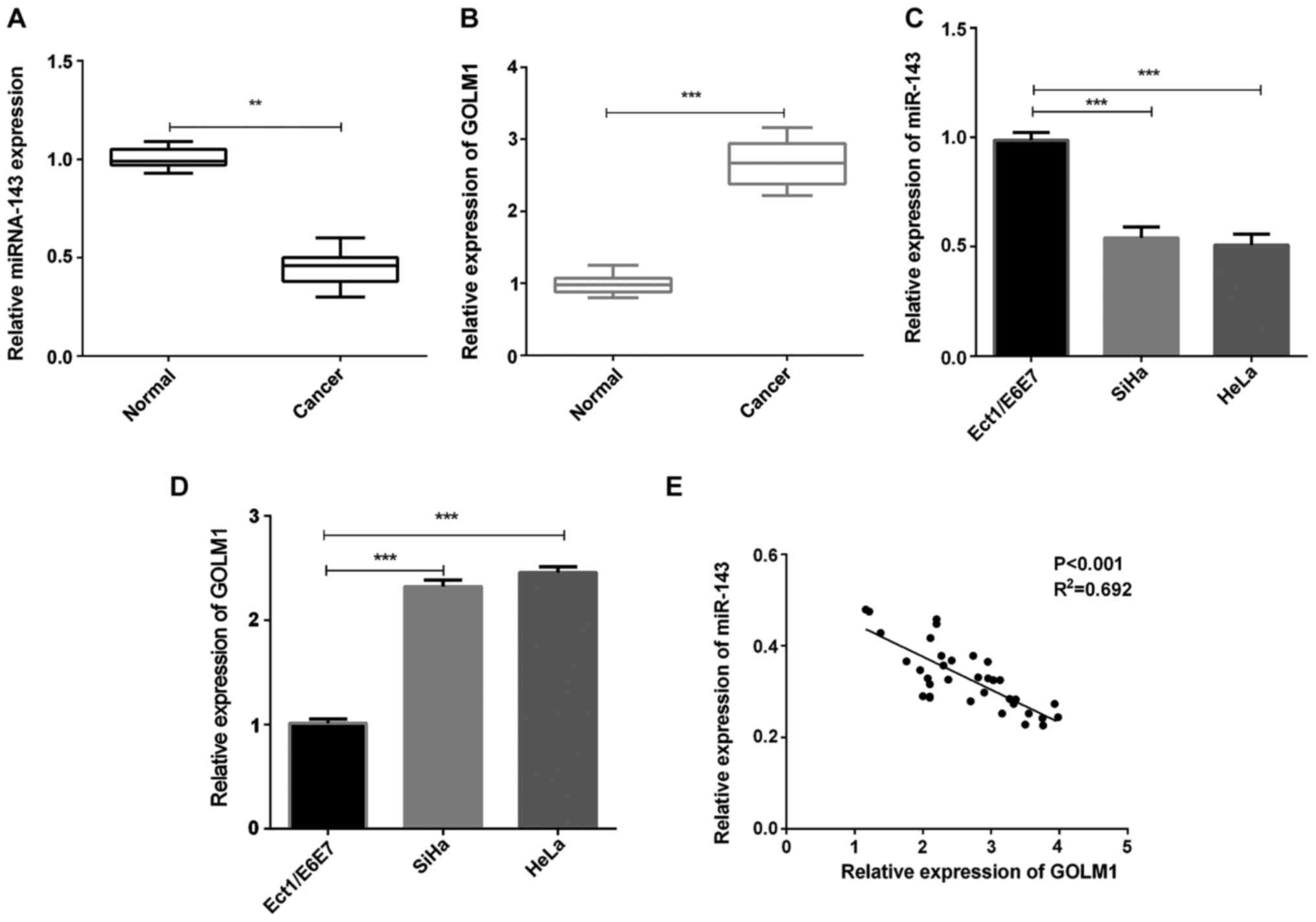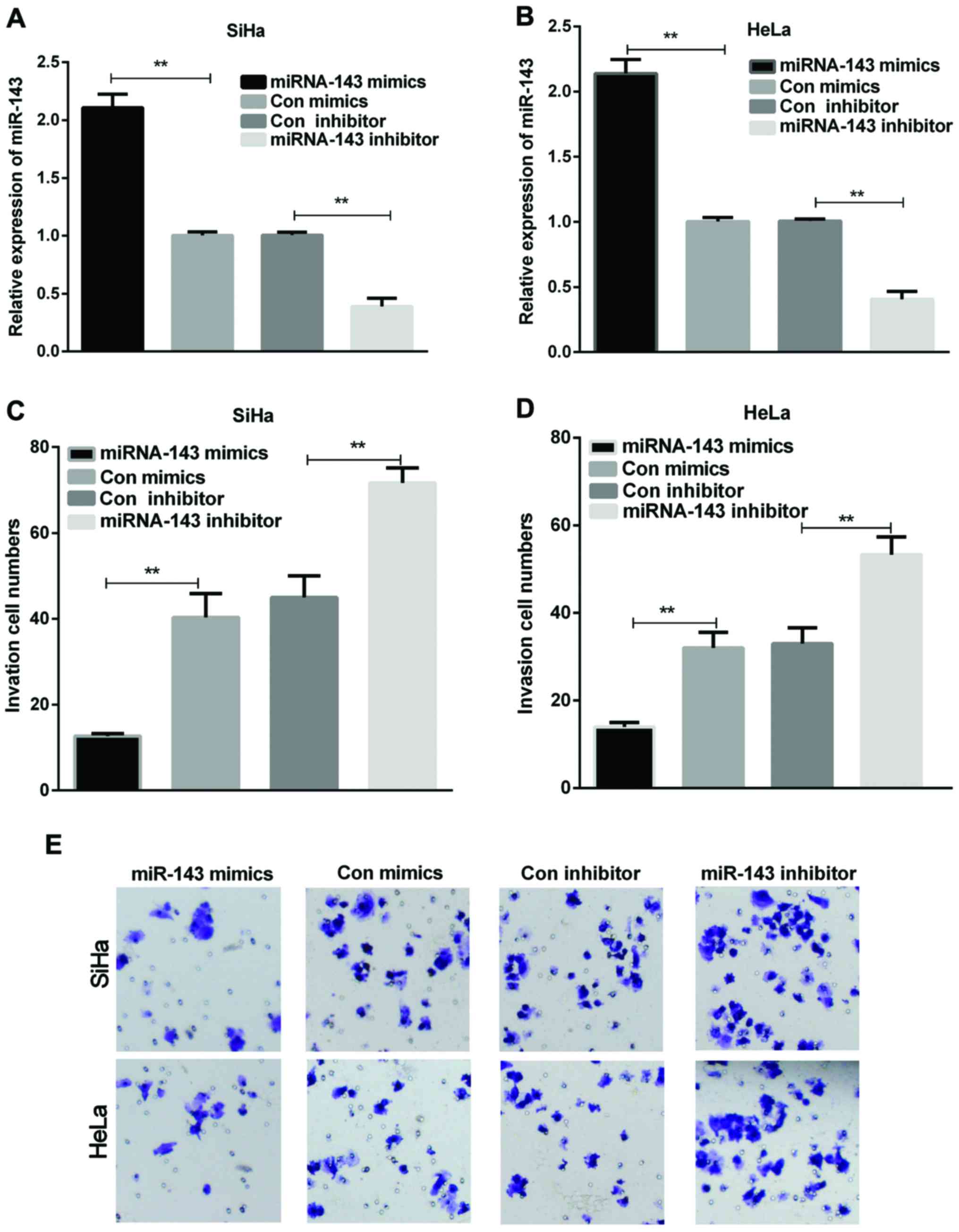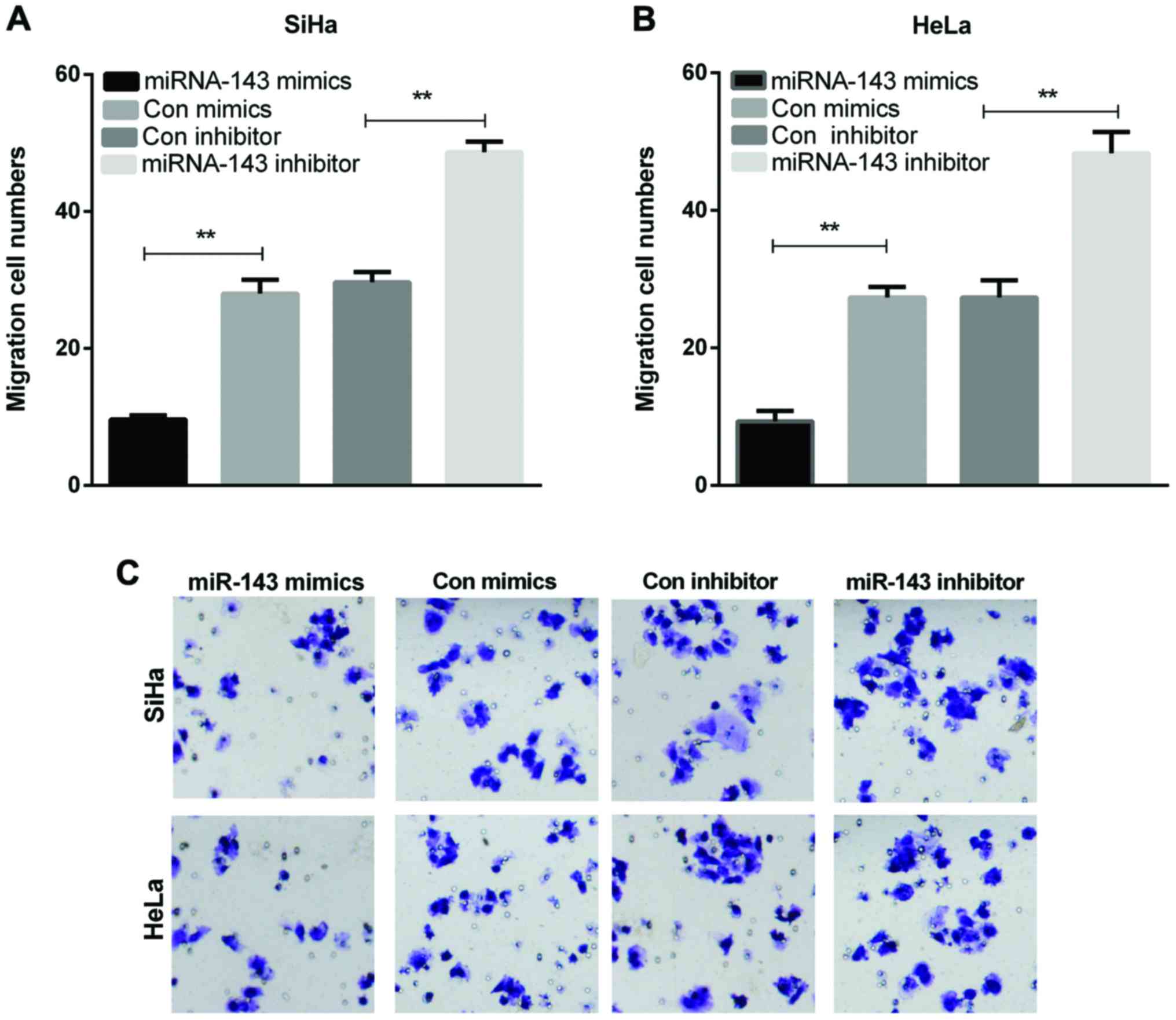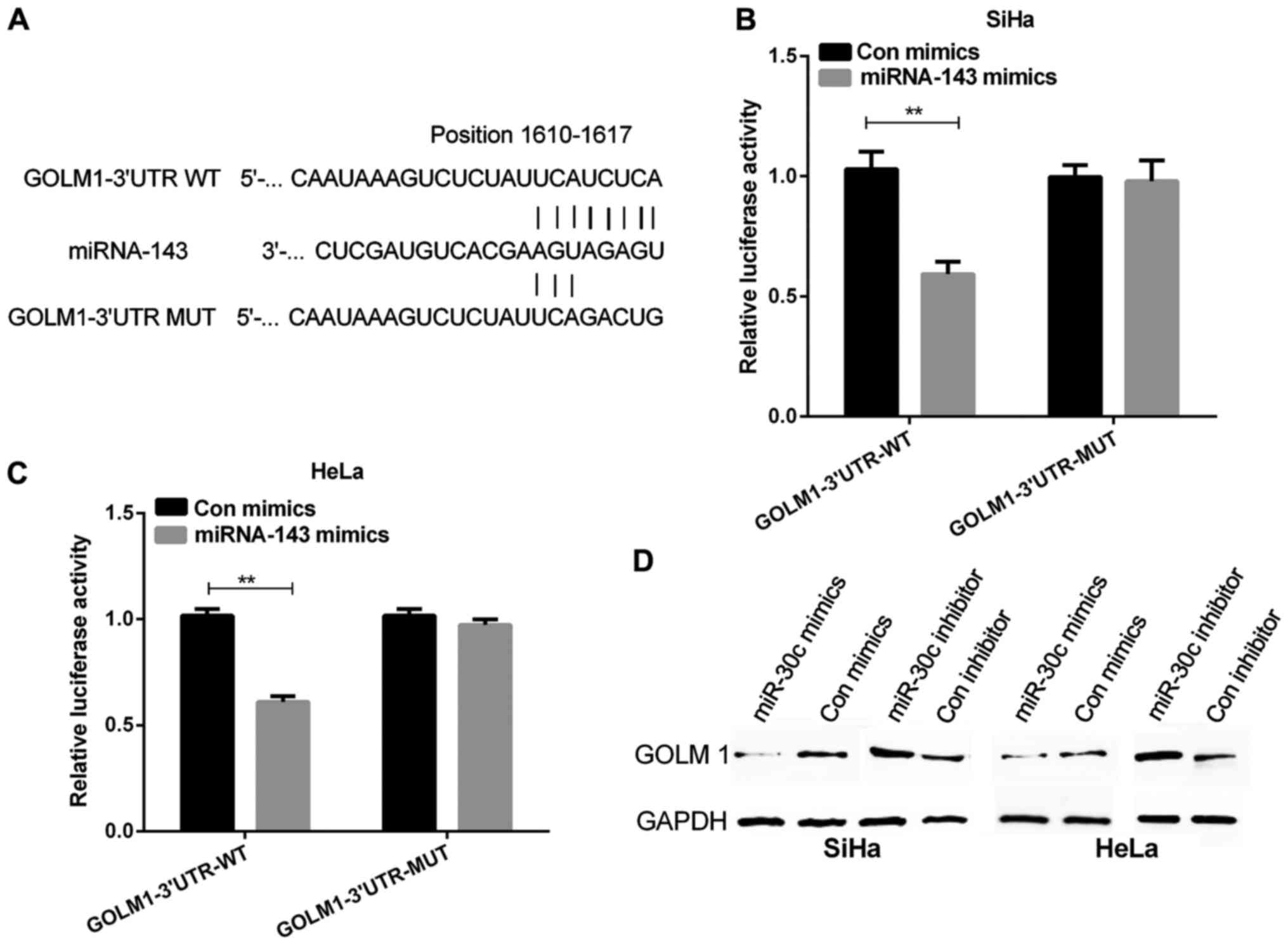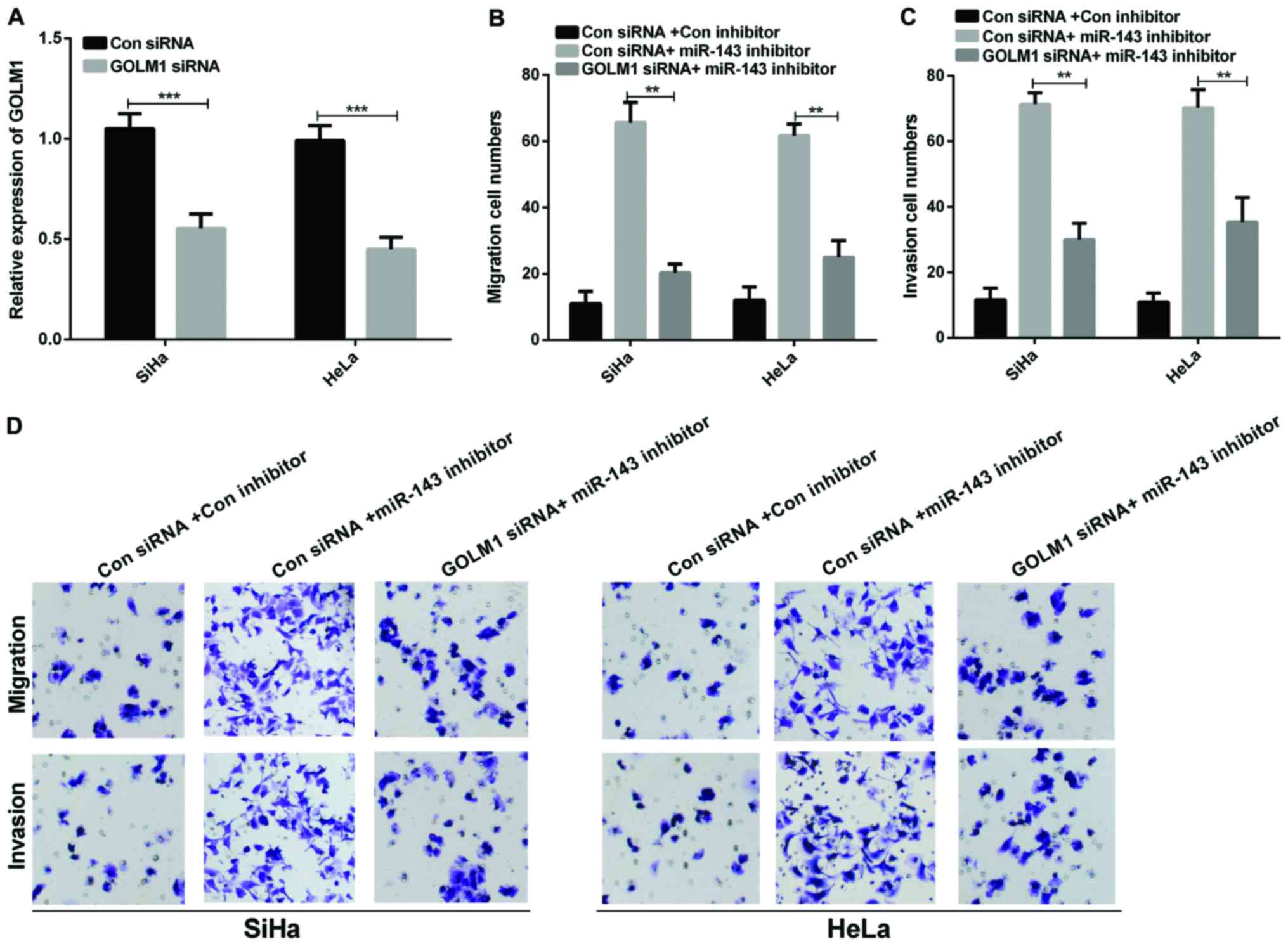Introduction
Cervical cancer, one leading cause of tumor-related
deaths, is a common gynecological tumor globally (1). Due to delayed initial screening, the
lack of early diagnosis and the unavailable widespread screening by
cervical cytology (2), cervical
cancer mainly occurs in developing countries and causes
approximately 265,000 deaths every year worldwide (3). In addition, approximately 85% of new
cervical cancer cases occur in lower socioeconomic countries
(4). Emerging studies indicate that
risk factors, such as infection of high-risk types of human
papillomavirus (HPV), promiscuity and early sexual intercourse,
have essential effects on cervical cancer progression (5). The normal cervical epithelium in
cervical cancer can be transformed into a precancerous cervical
intraepithelial neoplasia, and then develop into invasive cervical
cancer (6). Despite the effort which
has been made in the treatment, cervical cancer 5-year overall
survival rate still remains unsatisfactory (7). Despite the recent published research,
cervical cancer etiology remains unclear. Hence, in the current
study, we strived to investigate the molecular mechanisms
implicated in the cervical cancer occurrence and development and to
study more effective therapeutic targets for cervical cancer
treatment.
Recently, increased attention has been paid to the
role of microRNAs in various human cancers. miRNAs, a sizable class
of highly conserved, non-protein-coding and short RNAs of ~21–25
nucleotides (8), regulate gene
expression by binding to their 3′UTRs (9). miRNAs can also act as regulators of
various pathological and physiological processes, such as cell
differentiation, apoptosis, proliferation, invasion and migration.
An increasing number of studies indicate that miRNAs are abnormally
expressed in multiple tumors, inhibiting or promoting the
progression of cancers (10).
miRNA-143 has been featured as cancer suppressor in various cancers
(11,12). However, its possible functions and
underlying mechanisms in cervical cancer have remained unknown.
This study aimed to elucidate the expression and effects of miR-143
in cervical cancer, as well as investigate its underlying
mechanisms.
Golgi membrane protein 1 (GOLM1), one of the
transmembrane proteins of Golgi cisternae, is induced by viral
infection (13) and commonly
expressed in epithelial cells of normal tissues (14). TargetScan database analysis showed
that GOLM1 was one potential direct target for miRNA-143. Few
studies have found that GOLM1 may act as a biomarker for the
hepatocellular carcinoma (HCC) early diagnosis (15). However, the mechanism and function of
GOLM1 have not been investigated in cervical cancer. The current
study aimed to investigate the functional significance of miRNA-143
and to identify the relationship between miR-143 and the molecular
targets regulated by miRNA-143 in cervical cancer.
Materials and methods
Clinical specimens
Cervical cancer tissue samples and para-carcinoma
tissues were collected from 35 patients from the Gansu Provincial
Hospital (Lanzhu, China) between 2015 and 2017 (the clinical
characteristics are shown in Table
I). Each patient provided informed consent and the study was
approved by the Ethics Committee of The Gansu Provincial Hospital.
All tissue samples were snap-frozen in liquid nitrogen and saved at
−80°C.
 | Table I.Correlation of miRNA-143 expression
with the clinicopathological characteristics of the cervical cancer
patients. |
Table I.
Correlation of miRNA-143 expression
with the clinicopathological characteristics of the cervical cancer
patients.
|
|
| miRNA-143
expression |
|
|---|
|
|
|
|
|
|---|
| Clinicopathological
features | Cases (n=35) | High (n=15) | Low (n=20) | P-value |
|---|
| Age (years) |
|
|
| 0.2048 |
|
>60 | 16 | 6 | 10 |
|
| ≤60 | 19 | 9 | 10 |
|
| Family history of
cancer |
|
|
| 0.6257 |
| Yes | 18 | 7 | 11 |
|
| No | 17 | 8 | 9 |
|
| Tumor size (cm) |
|
|
| 0.0024 |
| ≥5.0 | 19 | 4 | 15 |
|
|
<5.0 | 16 | 11 | 5 |
|
| TNM stage |
|
|
| 0.0039 |
| I–II | 17 | 11 | 6 |
|
| III | 18 | 4 | 14 |
|
| Lymph node
metastasis |
|
|
| 0.0020 |
| Yes | 20 | 4 | 16 |
|
| No | 15 | 11 | 4 |
|
| Pausimenia |
|
|
| 0.4658 |
|
Yes | 18 | 7 | 11 |
|
| No | 17 | 8 | 9 |
|
| FIGO stage |
|
|
| 0.0017 |
|
I–II | 16 | 12 | 4 |
|
|
III–IV | 19 | 3 | 16 |
|
| Distant
metastasis |
|
|
| 0.5236 |
|
Yes | 17 | 6 | 11 |
|
| No | 18 | 9 | 9 |
|
Cell lines
Normal cervical epithelial cells (Ect1/E6E7) and two
cervical cancer cell lines (SiHa and HeLa) were purchased from the
American Type Culture Collection (Manassas, VA, USA) and maintained
in RPMI-1640 medium which contained 10% fetal bovine serum (FBS).
The cells were incubated in an atmosphere containing 5%
CO2 at 37°C.
Cell transfection
miRNA-143 mimics, miRNA-143 inhibitor or GOLM1 small
interfering RNA (siRNA) as well as the corresponding controls were
obtained from Guangzhou RiboBio Co., Ltd. (Guangzhou, China) and
transfected into human cervical cancer cell lines by Lipofectamine
2000 (Invitrogen: Thermo Fisher Scientific, Inc., Carlsbad, CA,
USA) in line with the manufacturer's instructions. The cells were
harvested 48 h post-transfection for further assays.
Reverse transcription-quantitative PCR
(RT-qPCR)
TRIzol reagent (Invitrogen: Thermo Fisher
Scientific, Inc.) was used to isolate the total RNA from cervical
cancer tissues and cells. cDNA was synthesized from 1 µg total RNA
with a High Capacity cDNA Reverse Transcription kit (Applied
Biosystems: Thermo Fisher Scientific, Inc., Foster City, CA, USA).
RT-qPCR was carried out on CFX96 real-time PCR detection system
(Bio-Rad Laboratories, Inc., Hercules, CA, USA) with SYBR Premix Ex
Taq™ (Takara Biotechnology Co., Ltd., Dalian, China). The relative
expression of mRNA was analysed using 2−ΔΔCq (16) (Table
II).
 | Table II.Primer sequences for RT-qPCR. |
Table II.
Primer sequences for RT-qPCR.
| Primers | Sequences |
|---|
| miR-143 | F
5′-TGTAGTTTTCGGAGTTAGTGTCGCGC-3′ |
|
| R
5′-CCTACGATCGAAAACGACGCGAACG-3′ |
| U6 | F
5′-GTTTTGTAGTTTTTGGAGTTAGTGTTGTGT-3′ |
|
| R
5′-CTCAACCTACAATCAAAAACAACACAAACA-3′ |
| GOLM1 | F
5′-CGTGGAGCTGAAGAAGAACGAG-3′ |
|
| R
5′-CCTGGTACAGCTTGTTGACGCT-3′ |
| GAPDH | F
5′-CACAATTGGGACCACAAGGG-3′ |
|
| R
5′-AACTCATCACAGCACGTCACACC-3′ |
Migration and invasion assay
Transwell assays were conducted to value the
cervical cancer cell invasion and migration capacities. A total of
1×105 cells with transfection of miR-143 mimics or
inhibitor were detached, suspended and seeded in the upper chamber.
In the meantime, DMEM containing 10% FBS was added to the bottom
chambers. The difference between invasion and migration assays was
that the Transwell upper chambers were precoated with Matrigel for
invasion assays. After incubation for 24 h, the cells that remained
on the upper chambers were removed with cotton swabs whereas the
cells attached to the lower chambers were fixed and stained,
respectively, using formaldehyde (4%) and crystal violet (0.1%) for
the detection of the images under a microscope (Olympus Corp.,
Tokyo, Japan) in five randomly selected fields.
Western blot analysis
The cells were lysed in chilled RIPA lysis buffer on
ice, and then centrifuged at 12,000 × g for 20 min at 4°C and
collected the supernatants. Protein concentrations were assessed
with a BCA Protein Assay kit (Bio-Rad Laboratories, Inc.). Protein
lysate was separated by 10% SDS-PAGE, followed by being
electroblotted onto a PVDF membrane (DuPont, Boston, MA, USA),
which had been blocked with 5% non-fat milk in TBST for 1 h at room
temperature. Next, the membrane was incubated with the primary
antibodies: anti-GOLM1 antibody (1:300, cat. no. HPA010638; Atlas
Antibodies, Stockholm, Sweden) and anti-GAPDH antibody (1:3,000;
cat. no. ab9485) at 4°C overnight, and then rinsed the membrane and
incubated it with anti-rabbit IgG (1:4,000; cat. no. ab191866)
(both from Abcam, Cambridge, UK) for 2 h at room temperature.
Chemiluminescence detection system (Beyotime Institute of
Biotechnology, Shanghai, China) was used to detect the results and
the protein expression was normalized to GAPDH.
Luciferase assay
The luciferase reporter assays were carried out to
evaluate whether GOLM1 was targeted by miRNA-143. Cervical cancer
cells were co-transfected with the wild-type or mutant GOLM1 3′UTR
luciferase reporter vectors and miRNA-143 by Lipofectamine™ 2000
(Invitrogen: Thermo Fisher Scientific, Inc.). After transfection
(48 h), Dual-Luciferase Reporter Assay System (Promega Corp.,
Madison, WI, USA) was used to measure the luciferase
activities.
Statistical analysis
All the experiments were performed at least 3 times.
The SPSS 18.0 version (SPSS, Inc., Chicago, IL, USA) and GraphPad
Prism 6 (GraphPad Software, Inc., La Jolla, CA, USA) were used to
evaluate the statistical analysis. Students t test and one way
ANOVA followed by Tukeys post hoc test were used to analyze two or
multiple groups, respectively. Spearmans correlation analysis was
used to determnine the correlation between miR-143 and GOLM1
expressions in cervical cancer tissues. P<0.05 was considered to
be a statistically significant difference.
Results
miRNA-143 is downregulated and GOLM1
is overexpressed in cervical cancer
We first evaluated the expression of miR-143 and
GOLM1 in cervical cancer tissue specimens. The results showed that
the miRNA-143 expression in cervical cancer tissues was remarkably
reduced in contrast with the normal tissue samples (Fig. 1A, P<0.01), whereas the GOLM1 mRNA
expression in cervical cancer tissue samples was significantly
increased (Fig. 1B, P<0.001). The
expression of miRNA-143 and GOLM1 was then measured in cervical
cancer cells (SiHa and HeLa). The results indicated that, compared
to the control group, miRNA-143 expression in both SiHa and HeLa
cells was significantly decreased (Fig.
1C, P<0.001), whereas the GOLM1 expression was significantly
increased (Fig. 1D, P<0.001).
Additionally, statistical analysis revealed that the miRNA-143
expression was negatively correlated with GOLM1 expression in the
cervical cancer tissue samples (Fig.
1E). miRNA-143 suppresses cervical cancer cell invasion. HeLa
and SiHa cells were transfected with miRNA-143 mimics or inhibitor,
respectively. After 48 h, the transfection efficiency was measured.
The results demonstrated that the miRNA-143 expression was
dramatically upregulated in both SiHa and HeLa cells with
transfection of miRNA-143 mimics, while the miRNA-143 expression
level was downregulated in cervical cancer cells treated with
miRNA-143 inhibitor (Fig. 2A and B,
P<0.01). Additionally, cell invasion assay was performed using
Transwell chambers. In the cell invasion assay, the overexpression
of miRNA-143 decreased SiHa and HeLa cell invasion, whereas
inhibition of the miRNA-143 expression enhanced SiHa and HeLa cell
invasion (Fig. 2C-E, P<0.01). The
results manifested that miR-143 inhibited cervical cancer cell
invasion.
miRNA-143 inhibits cell migration in
cervical cancer cells
To explore the functions of miRNA-143 in metastasis,
cell migration assay was also carried out by Transwell chambers.
The overexpression of miRNA-143 significantly decreased SiHa and
HeLa cell migration, whereas inhibiting the miRNA-143 expression
increased SiHa and HeLa cell migration (Fig. 3A-C, P<0.01). This result indicated
that miRNA-143 inhibited cervical cancer cell migration.
GOLM1 is a direct target of
miRNA-143
To investigate the mechanism of miRNA-143 in
inhibiting cervical cancer, we continued to explore the potential
targets of miRNA-143. In the present study, TargetScan was used to
find accurate potential target genes of miRNA-143, and it predicted
GOLM1 as a potential target of miRNA-143. The wild-type and mutant
GOLM1 3′UTRs were generated with sequences presented in Fig. 4A. Luciferase reporter assay was
performed on cervical cancer cells which were transfected with
miRNA-143 mimics. Subsequently, cells were co-transfected with wild
or mutant GOLM1 3′UTR vectors. The results revealed that the
miRNA-143 mimics remarkably declined luciferase activity of the
GOLM1 3′UTR-wt vector. Moreover, the luciferase activity of GOLM1
3′UTR-mut vector was not affected by miRNA-143 mimics (Fig. 4B and C, P<0.01). Our findings
suggested that GOLM1 was directly targeted by miRNA-143. In
addition, the GOLM1 protein expression was remar-kably reduced in
cells with the transfection of miRNA-143 mimics and obviously
increased in cells with the transfection of miRNA-143 inhibitor
compared with their respective controls (Fig. 4D).
The effects of GOLM1 on regulating the
effects of miR-143 on cervical cancer cell invasion and
migration
We sequentially studied whether GOLM1 was needed in
regulating the miR-143 ability in cell invasion and migration of
cervical cancer. GOLM1 siRNAs were transfected into SiHa and HeLa
cells to knockdown endogenous GOLM1 and RT-qPCR was conducted to
examine the GOLM1 mRNA expression. The results revealed that the
GOLM1 expression in cervical cancer cells transfected with GOLM1
siRNAs was significantly reduced compared to the control group
(Fig. 5A, P<0.001). Furthermore,
Transwell assays were conducted to measure the invasion and
migration of cervical cancer cells co-transfected with GOLM1 siRNA
and miR-143 inhibitor. Our above results indicate that deletion of
GOLM1 markedly reversed miR-143-medicated suppression of cell
migration and invasion in cervical cancer cells (Fig. 5B-D, P<0.01).
Discussion
Despite regular cancer screening, cervical cancer
still remains a common tumor in women (17). It is important to elucidate the
underlying mechanism of cervical cancer development. Increasing
number of research has indicated that the aberrant miRNA expression
has important functions in tumor progression. Previous studies also
demonstrated that the dysregulation of miRNAs potentially serves as
a therapeutic target in various cancers including cervical cancer
(18,19). Therefore, the study of the miRNA
expression and functions in cervical cancer may help to improve the
treatment strategy for refractory cervical cancer.
miRNA-143 is one of the most crucial miRNAs which
has been implicated in tumor progression. Previously, it has been
verified that miR-143 is downregulated in various tumors and can
inhibit the development of multiple cancers including leukemia
(20), breast cancer (21), and osteosarcoma (22). The miRNA-143 expression has been found
to be significantly downregulated in many tumors (23,24),
involving human cervical cancer tissues (25), thus, demonstrating a potentially
suppressive effect of miRNA-143 on tumor development. Nevertheless,
limited efforts have been made to elucidate the mechanism of
miRNA-143 in cervical cancer. The role of miRNA-143 in the
regulation of cell migration and invasion remains unclear.
GOLM1 has two variants which encode the same protein
(26). Previous studies have
demonstrated that the GOLM1 expression is overexpressed in human
PCa tissues (27), HCC (28), and lung adenocarcinoma (29). Nevertheless, little is known about the
possible role of GOLM1 in cervical cancer. The present study aimed
to reveal the relationship between the miRNA-143 and GOLM1
expression in cervical cancer. Data revealed that the miRNA-143
expression was downregulated dramatically in cervical cancer tissue
samples in contrast to normal samples while GOLM1 was overexpressed
in cervical cancer tissue samples. Moreover, the low expression of
miRNA-143 and GOLM1 overexpression were also found in cervical
cancer cells. In addition, the miRNA-143 expression negatively
correlated with the GOLM1 expression in cervical cancer tissues. We
also found that miRNA-143 suppressed cell invasion and migration by
modulating GOLM1 in cervical cancer.
In summary, our study demonstrated that the
miRNA-143 expression is low in cervical cancer and it inhibited
cell invasion and migration via targeting GOLM1. These data
provided new insights into the tumor-suppressive effects of
miRNA-143 in cervical cancer, suggesting that miRNA-143 may be a
therapeutic strategy and an effective biomarker for cervical cancer
treatment in the future.
Acknowledgements
Not applicable.
Funding
No funding was received.
Availability of data and materials
The datasets used and/or analyzed during the present
study are available from the corresponding author on reasonable
request.
Authors' contributions
MZ and XC contributed to the conception of the
study. JW contributed significantly to the analysis and manuscript
preparation. XH performed the data analyses and contributed to the
writing of the manuscript. RR helped to perform the statistical
analysis with constructive discussions. All authors read and
approved the final manuscript.
Ethics approval and consent to
participate
This study was approved by the Ethics Committee of
the Gansu Provincial Hospital (Lanzhou, China). Each patient
enrolled in this study provided a signed informed consent.
Patient consent for publication
Not applicable.
Competing interests
The authors declare that they have no competing
interests.
References
|
1
|
Li XL, Liu XX, Cao GS, Ju DD and Jiang H:
Narrowing resection of parametrial tissues is feasible in low-risk
cases of stage IA2-IB1 cervical cancer. J Cancer. 7:1481–1486.
2016. View Article : Google Scholar : PubMed/NCBI
|
|
2
|
Torre LA, Bray F, Siegel RL, Ferlay J,
Lortet-Tieulent J and Jemal A: Global cancer statistics, 2012. CA
Cancer J Clin. 65:87–108. 2015. View Article : Google Scholar : PubMed/NCBI
|
|
3
|
Tjalma WAA: Diagnostic performance of
dual-staining cytology for cervical cancer screening: A systematic
literature review. Eur J Obstet Gynecol Reprod Biol. 210:275–280.
2017. View Article : Google Scholar : PubMed/NCBI
|
|
4
|
Malo TL, Perkins RB, Lee JH and
Vadaparampil ST: Primary care physicians' adherence to expert
recommendations for cervical cancer screening and prevention in the
context of human papillomavirus vaccination. Sex Transm Dis.
43:438–444. 2016. View Article : Google Scholar : PubMed/NCBI
|
|
5
|
Yu Y, Zhang Y and Zhang S: MicroRNA-92
regulates cervical tumorigenesis and its expression is upregulated
by human papillomavirus-16 E6 in cervical cancer cells. Oncol Lett.
6:468–474. 2013. View Article : Google Scholar : PubMed/NCBI
|
|
6
|
Schiffman M and Wentzensen N: Human
papillomavirus infection and the multistage carcinogenesis of
cervical cancer. Cancer Epidemiol Biomarkers Prev. 22:553–560.
2013. View Article : Google Scholar : PubMed/NCBI
|
|
7
|
Du J, Wang L, Li C, Yang H, Li Y, Hu H, Li
H and Zhang Z: MicroRNA-221 targets PTEN to reduce the sensitivity
of cervical cancer cells to gefitinib through the PI3K/Akt
signaling pathway. Tumour Biol. 37:3939–3947. 2016. View Article : Google Scholar : PubMed/NCBI
|
|
8
|
Sun K and Lai EC: Adult-specific functions
of animal microRNAs. Nat Rev Genet. 14:535–548. 2013. View Article : Google Scholar : PubMed/NCBI
|
|
9
|
Ambros V: The functions of animal
microRNAs. Nature. 431:350–355. 2004. View Article : Google Scholar : PubMed/NCBI
|
|
10
|
Zhang L, Huang J, Yang N, Greshock J,
Megraw MS, Giannakakis A, Liang S, Naylor TL, Barchetti A, Ward MR,
et al: microRNAs exhibit high frequency genomic alterations in
human cancer. Proc Natl Acad Sci USA. 103:9136–9141. 2006.
View Article : Google Scholar : PubMed/NCBI
|
|
11
|
Li WH, Wu HJ, Li YX, Pan HG, Meng T and
Wang X: MicroRNA-143 promotes apoptosis of osteosarcoma cells by
caspase-3 activation via targeting Bcl-2. Biomed Pharmacother.
80:8–15. 2016. View Article : Google Scholar : PubMed/NCBI
|
|
12
|
Wu D, Huang P, Wang L, Zhou Y, Pan H and
Qu P: MicroRNA-143 inhibits cell migration and invasion by
targeting matrix metalloproteinase 13 in prostate cancer. Mol Med
Rep. 8:626–630. 2013. View Article : Google Scholar : PubMed/NCBI
|
|
13
|
Kladney RD, Bulla GA, Guo L, Mason AL,
Tollefson AE, Simon DJ, Koutoubi Z and Fimmel CJ: GP73, a novel
Golgi-localized protein upregulated by viral infection. Gene.
249:53–65. 2000. View Article : Google Scholar : PubMed/NCBI
|
|
14
|
Zhou Y, Li L, Hu L and Peng T: Golgi
phosphoprotein 2 (GOLPH2/GP73/GOLM1) interacts with secretory
clusterin. Mol Biol Rep. 38:1457–1462. 2011. View Article : Google Scholar : PubMed/NCBI
|
|
15
|
Mao Y, Yang H, Xu H, Lu X, Sang X, Du S,
Zhao H, Chen W, Xu Y, Chi T, et al: Golgi protein 73 (GOLPH2) is a
valuable serum marker for hepatocellular carcinoma. Gut.
59:1687–1693. 2010. View Article : Google Scholar : PubMed/NCBI
|
|
16
|
Livak KJ and Schmittgen TD: Analysis of
relative gene expression data using real-time quantitative PCR and
the 2(-Delta Delta C(T)) Method. Methods. 25:402–408. 2001.
View Article : Google Scholar : PubMed/NCBI
|
|
17
|
Janicek MF and Averette HE: Cervical
cancer: Prevention, diagnosis, and therapeutics. CA Cancer J Clin.
51:92–114. 2001. View Article : Google Scholar : PubMed/NCBI
|
|
18
|
Shi C and Zhang Z: MicroRNA-362 is
downregulated in cervical cancer and inhibits cell proliferation,
migration and invasion by directly targeting SIX1. Oncol Rep.
37:501–509. 2017. View Article : Google Scholar : PubMed/NCBI
|
|
19
|
Lin M, Xue XY, Liang SZ, Li YX, Lv YY, He
LH, Xu KC, Zhang LF, Chen JB and Niu LZ: MiR-187 overexpression
inhibits cervical cancer progression by targeting HPV16 E6.
Oncotarget. 8:62914–62926. 2017.PubMed/NCBI
|
|
20
|
Akao Y, Nakagawa Y, Kitade Y, Kinoshita T
and Naoe T: Downregulation of microRNAs-143 and −145 in B-cell
malignancies. Cancer Sci. 98:1914–1920. 2007. View Article : Google Scholar : PubMed/NCBI
|
|
21
|
Chang YY, Kuo WH, Hung JH, Lee CY, Lee YH,
Chang YC, Lin WC, Shen CY, Huang CS, Hsieh FJ, et al: Deregulated
microRNAs in triple-negative breast cancer revealed by deep
sequencing. Mol Cancer. 14:362015. View Article : Google Scholar : PubMed/NCBI
|
|
22
|
Osaki M, Takeshita F, Sugimoto Y, Kosaka
N, Yamamoto Y, Yoshioka Y, Kobayashi E, Yamada T, Kawai A, Inoue T,
et al: MicroRNA-143 regulates human osteosarcoma metastasis by
regulating matrix metalloprotease-13 expression. Mol Ther.
19:1123–1130. 2011. View Article : Google Scholar : PubMed/NCBI
|
|
23
|
Gregersen LH, Jacobsen A, Frankel LB, Wen
J, Krogh A and Lund AH: MicroRNA-143 down-regulates Hexokinase 2 in
colon cancer cells. BMC Cancer. 12:2322012. View Article : Google Scholar : PubMed/NCBI
|
|
24
|
Wu XL, Cheng B, Li PY, Huang HJ, Zhao Q,
Dan ZL, Tian DA and Zhang P: MicroRNA-143 suppresses gastric cancer
cell growth and induces apoptosis by targeting COX-2. World J
Gastroenterol. 19:7758–7765. 2013. View Article : Google Scholar : PubMed/NCBI
|
|
25
|
Honegger A, Schilling D, Bastian S,
Sponagel J, Kuryshev V, Sültmann H, Scheffner M, Hoppe-Seyler K and
Hoppe-Seyler F: Dependence of intracellular and exosomal microRNAs
on viral E6/E7 oncogene expression in HPV-positive tumor cells.
PLoS Pathog. 11:e10047122015. View Article : Google Scholar : PubMed/NCBI
|
|
26
|
Kim HJ, Lv D, Zhang Y, Peng T and Ma X:
Golgi phosphoprotein 2 in physiology and in diseases. Cell Biosci.
2:312012. View Article : Google Scholar : PubMed/NCBI
|
|
27
|
Li W, Wang X, Li B, Lu J and Chen G:
Diagnostic significance of overexpression of Golgi membrane protein
1 in prostate cancer. Urology. 80:952.e1–7. 2012. View Article : Google Scholar
|
|
28
|
Bachert C, Fimmel C and Linstedt AD:
Endosomal trafficking and proprotein convertase cleavage of cis
Golgi protein GP73 produces marker for hepatocellular carcinoma.
Traffic. 8:1415–1423. 2007. View Article : Google Scholar : PubMed/NCBI
|
|
29
|
Zhang F, Gu Y, Li X, Wang W, He J and Peng
T: Up-regulated Golgi phosphoprotein 2 (GOLPH2) expression in lung
adenocarcinoma tissue. Clin Biochem. 43:983–991. 2010. View Article : Google Scholar : PubMed/NCBI
|















